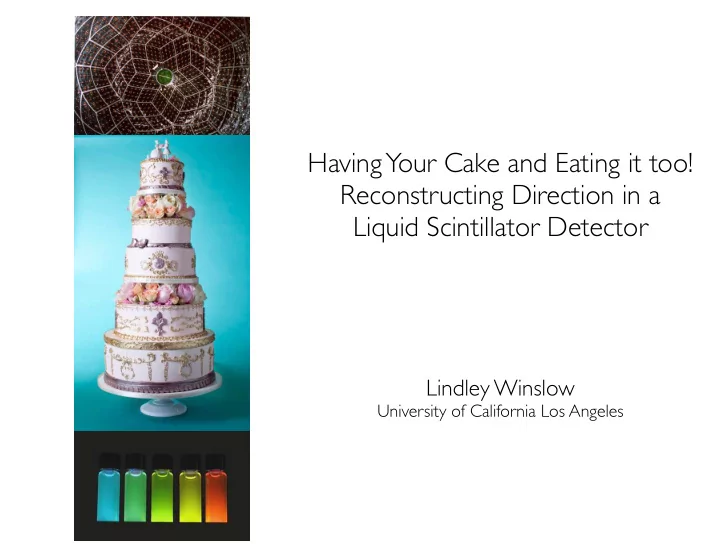

Having Your Cake and Eating it too! Reconstructing Direction in a Liquid Scintillator Detector Lindley Winslow University of California Los Angeles
Scintillation Cherenkov Light Light
Energy Directionality Resolution
I am particularly interested in Neutrinoless Double Beta Decay. e - e - ν i ν i ➢ Nucleus Z+2 Nucleus Z ➢ Nuclear Process So I really care about the energy resolution.
Neutrinoless Double Beta Decay (Cerenkov Only) ... but some directionality would be nice!
136 Xe 2 νββ Cherenkov threshold is ~0.2MeV. 76 Ge 0 νββ
Probably a 136 Xe 2 νββ statistical separation will be needed. 76 Ge 0 νββ
So how are we going to do this?
The Cherenkov light is still there... Number of Cherenkov Photons for a 1MeV e- absorbed by scintillator Retains directional information!
Longer wavelengths travel faster in scintillator and scintillation processes have inherent time constants.
Using the KamLAND index of refraction... the velocity at 370nm is 0.191m/s and at 600nm is 0.203nm.
Simple KamLAND Geant4 scintillation simulation (not using GLG4sim) with scintillator properties from KamLAND.
Simple KamLAND Assumed 100% coverage and quantum efficiency as measured for the Double Chooz PMTs (~20% like KamLAND but a better measurement).
Simple KamLAND The default photodetector timing is improved to match that of LAPPDs or Hybrid PMTs.
Simple KamLAND The rise time of a typical scintillator is often not quoted. We are using 1ns as an estimate from timing data for the Double Chooz LS.
arXiv:1307.5813 So if you have good enough timing.... PEs per event/0.1 ns 50 40 30 20 10 0 30 35 40 45 50 Time [ns] you should be able to separate the scarce Cherenkov from the abundant scintillation light.
This is the simulation with 0.1ns timing resolution. PEs per event/0.1 ns 50 40 30 20 The LAPPD 10 could 0 provide this! 30 35 40 45 50 Time [ns] R c/s = 0.63 arXiv:1307.5813
If we put this timing data into basic reconstruction algorithms (from WCsim)... we can reconstruct vertices and direction at the center of the detector. arXiv:1307.5813
5.0MeV 2.1MeV Reducing the energy we see the expected broadening due to photon statistics. 1.4MeV arXiv:1307.5813
Does this work with current photomultiplier tubes (i.e. the 17-inch PMTs currently used by KamLAND)?
This is a simulation of a 6.5m spherical detector with 1.28ns timing resolution. 50 PEs per event/0.1 ns 40 30 20 This is a 10 standard 0 30 35 40 45 50 large PMT. Time [ns] R c/s = 0.25 arXiv:1307.5813
The separation needs more red light.
What about a more red sensitive PMT? � ���������������������� ��� ����������������� ������������������������������� ������������������������������� ��� ��� �� � ��� ��� � ��� ��� ��� ��� ��� ��� ��� ��� ��� ���������������
This gives beautiful results! PEs per event/0.1 ns 60 50 40 30 20 10 0 30 35 40 45 50 Time [ns] The problem is R c/s = 1.01 it is a 1cm diameter PMT... arXiv:1307.5813
����� ������ ������������������������������ ������������������������������������������ ����������������������� What if I could narrow the emission spectrum? � ��� �������������������������� �������������������������������������������� ��� ������������������������������ ��������������� ��� �� � �� �� �� � ��� ��� ��� ��� ��� ��� ���������������
This is the narrowed emission spectrum with traditional PMTs and 0.1ns timing. PEs per event/0.1 ns 60 50 40 30 20 10 0 30 35 40 45 50 Time [ns] R c/s = 0.86 This is the quantum-dot- doped liquid scintillator.
Quantum Dot Doped Scintillator
What are quantum dots?
What are Quantum Dots? Quantum Dots are semiconducting nanocrystals. A shell of organic molecules is used to suspend them in an organic solvent (toluene) or water. Common materials are CdS, CdSe, CdTe...
Quantum Dot Materials Overlap with Candidate Isotopes! Isotope Endpoint Abundance 48 Ca 4.271 MeV 0.187% 150 Nd 3.367 MeV 5.6% 96 Zr 3.350 MeV 2.8% 100 Mo 3.034 MeV 9.6% 82 Se 2.995 MeV 9.2% 116 Cd 2.802 MeV 7.5% 130 Te 2.533 MeV 34.5% 136 Xe 2.479 MeV 8.9% 76 Ge 2.039 MeV 7.8% 128 Te 0.868 MeV 31.7%
Quantum dots provide the chemistry for suspending isotope in scintillator.
Why are they so popular? Because of their small size, their electrical and optical properties are more similar to atoms than bulk semiconductors. In fact, the optical properties of quantum dots with diameter <10nm is completely determined by their size. Their size is easily regulated during their synthesis. bigger smaller
Example CdS Quantum Dot Spectra: They absorb all light shorter than 400nm and re-emit it in a narrow resonance around this wavelength. Very Useful for Biology, Solar Cells, and LEDs! surface states=not good for us
We have found better quantum dots! JINST 8 (2013) P10015
We have made attenuation length measurements! We believe filtering is removing aggregated quantum dots. JINST 8 (2013) P10015
The Trilite450 quantum dots are looking good! JINST 8 (2013) P10015
Progress is being made in understanding the details of the quantum dot chemistry for our application.
ν .
ν . Next Steps: 25mL - Understand the chemistry 1m 3 Detector - Create a test stand for both the photodetectors and the scintillator and may be go underground....
The 1m 3 Detector a possible tank at LANL
ν . Recall you can have Two Neutrino Double Beta Decay: e - ν e e - ν e ➢ Nucleus Z+2 Nucleus Z ➢ Nuclear Process With 10g of 116 Cd, I expect 1000 events in 6 months.
ν . Next Steps: Take over a cavern and try a first large-scale deployment of LAPPDs and new scintillators.
Far Future Dreams.... From: K. Inoue
Thank you!
Whats new? Precision Spectrum Measurements Direct excitation of the toluene, understanding the energy transfer in the scintillator.
Whats new? Precision Spectrum Measurements Direct excitation of the quantum dots. At these high concentrations it seems the UV light can start changing the chemistry of the quantum dots.
Fitting to a three exponential model + PMT response: 4 Toluene + 5 g/L PPO 10 Sigma-Aldrich 380 nm Dots NN-Labs 360 nm Dots 3 10 2 10 10 -300 -250 -200 -150 -100 Photon Arrival Time [ns]
Recommend
More recommend